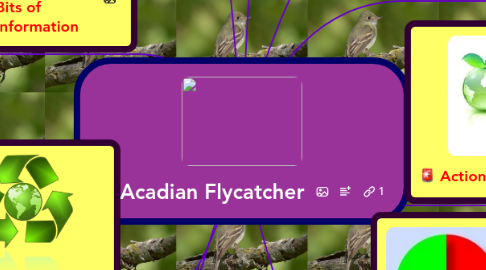Acadian Flycatcher
by nee s.


1. Biome
1.1. Maple-Beech Forests
1.2. Dedicious Forest Area (ON)
2. Human impacts
2.1. Forest Clearing
2.2. Forest Fragmentation
3. Interesting Facts and Bits of Information
3.1. The record for the longest living Acadian Flycatcher is between 10-11 years
3.2. In captivity,an acadian flycather can live for 10-11 years
3.3. The Acadian Flycatcher is a common host to the brood-parasitic Brown-headed Cowbird, which lays its eggs in other birds' nests.
3.4. The Acadian Flycatcher does not seem to be a particularly good host to the cowbird; : only 16% of cowbird young in Acadian Flycatcher nests fledged successfully.
3.5. The acadian flycatcher is an good flier and is extremely maneuverable and able to hover and even fly backward
4. My Resources
4.1. Ontario Species At Risk
4.2. Wikipedia
4.3. How Long Can Birds Live?
4.4. Images from Ontario Species At Risk and Google Images
4.5. All about birds
4.6. Toronto Wind Action
5. Habitat
5.1. Air
5.2. Shady foliage and shrubs
5.3. Tree tops of deciduous trees
6. Action Plan
6.1. The Acadian Flycatcher is protected under the Migratory Bird Convention Act
6.2. Make petitions to stop harming trees
6.3. Stop approval of building extra houses and buildings
6.4. Try using more eco-friendly products like Hilroy Recycled notebook paper
6.5. Plant trees! Deforestation is a big threat to Acadian Flycatchers, so why not help by planting trees?
6.6. Try doing things electronically- you save a lot of birds' trees
6.7. Raise awareness of the threats that the Acadian Flycatcher is faced with
7. Map
7.1. Ontario Range
7.2. North American Range
8. Biology
8.1. Size
8.1.1. Small ;only 15 cm in length
8.2. Colour
8.2.1. olive-green
8.2.2. Light brown
8.3. Life cycle
8.3.1. About 7 years
8.3.2. 1.Egg 2.Chick 3.Bird
8.4. Offspring
8.4.1. Usually 1–4 eggs at a time
8.4.2. Breeds in Deciduous forest tree tops
8.4.3. Eggs are white or speckled
8.5. Other features
8.5.1. Pale eye rings
8.5.2. Light-coloured wing bars
8.5.3. A short brown bill with a slightly hooked tip
8.5.4. Song bird with a an emphatic "ka-zeep"
8.5.5. Wingspan:23 cm
8.5.6. Weight:11–14 g
8.5.7. Eats insects
8.5.8. Migrates to Tropical Forests in Winter
